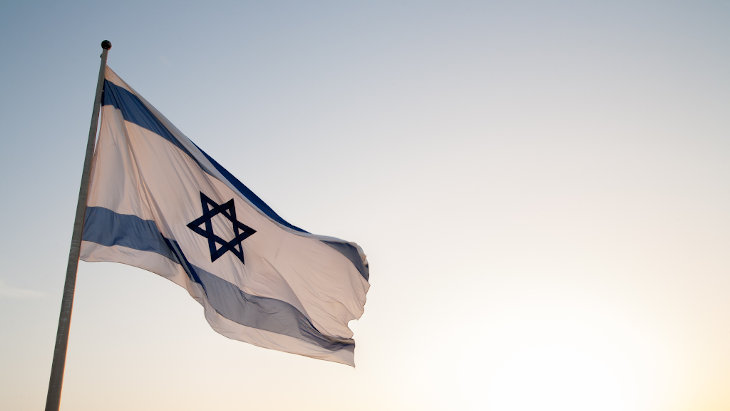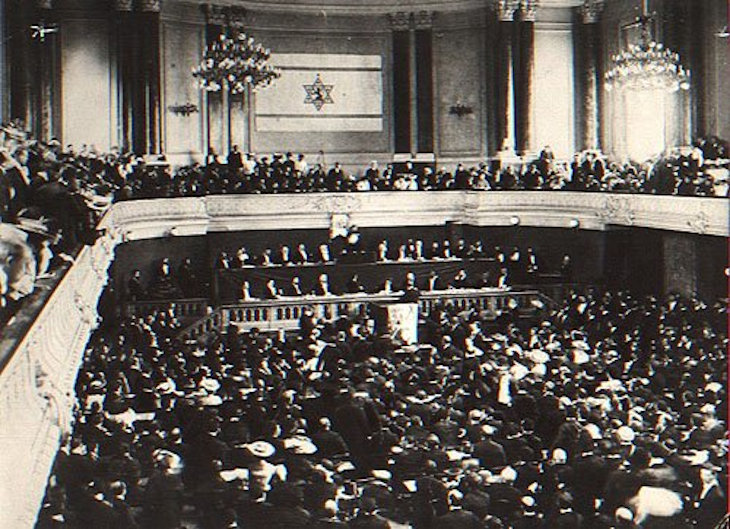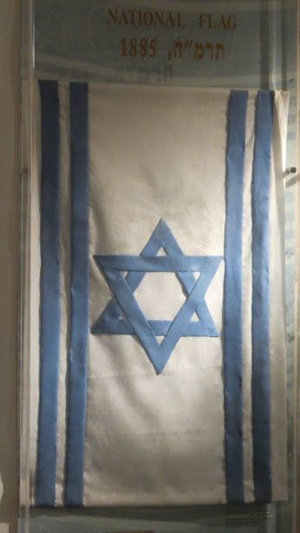 The Irrationality of Antisemitism
The Irrationality of Antisemitism


13 min read
The story behind Israel’s flag and why it’s a potent symbol for Jews worldwide.
Israel’s beautiful flag seems so familiar, yet when it was adopted one fine October day generations ago, it was only after months of intense debate. Here’s the story behind Israel’s national flag – and some facts about the hopes and hatreds that Israel’s flag has stirred through the years.
In the late 1800s, most of the world’s Jews lived in Europe. Many were rapidly assimilating into wider non-Jewish culture – including one highly educated Jewish lawyer, Budapest-born Theodor Herzl. After earning his law degree at the prestigious University of Vienna in 1884, Herzl wrote plays and the occasional piece for newspapers and magazines. He’d written for the Viennese newspaper Neue Freie Presse, and in 1891 that paper asked him to travel to Paris and report on a military court martial of a Jewish officer there named Alfred Dreyfus.
When Herzl and his wife arrived in Paris, they could hardly believe the situation there: the charges against Captain Dreyfus were patently false, and his court martial was drenched in anti-Semitism. Dreyfus’ trial split France, stirring up intense hatred of Jews. Herzl had witnessed anti-Semitism in his homeland of the Austro-Hungarian Empire, but he’d thought that France, home of the French Revolution and the Declaration of the Rights of Man, would be different.
 Flag seen at the 3rd Zionist Congress in Basel, 1899
Flag seen at the 3rd Zionist Congress in Basel, 1899
Herzl became convinced that Europe’s Jews were in grave danger, and that they urgently needed a homeland of their own. For millennia, Jews all around the world had fervently prayed for the moment when they could return to the land of Israel and once again dwell in their own Jewish country. Herzl decided to do all he could to make this dream a reality. After years of writing and meeting with Jewish leaders around the world, Herzl convened the First Zionist World Congress in Basel, Switzerland, in 1897. There, he and a succession of other Jewish leaders called for a Jewish country. One of the items they discussed was the makeup of a future Jewish national flag.
After the Zionist Congress concluded, Theodor Herzl wrote in his diary: “At Basel I founded the Jewish State. If I say this out loud today, I would be greeted by universal laughter. In five years perhaps, and certainly in fifty years, everyone will perceive it.” (Theodor Herzl, September 3, 1897). Though he didn’t live to see it, Herzl’s words were prophetic: forty nine years, two months and two weeks later, the State of Israel was established.
At the Zionist Congress in Basel, Herzl raised the question of what form a flag for the new Jewish state would be. As delegates discussed the matter, one German Jewish Zionist named David Wolffsohn stood up and captivated the attention of all the delegates.
David Wolffsohn was born into a traditional Jewish family in Lithuania in 1856. He eventually moved to the German city of Cologne and became a successful businessman – and worked tirelessly to help build a Jewish state and to aid his fellow Jews. When he heard that Theodor Herzl was calling for a Jewish country, Wolffsohn travelled to Vienna to meet with him. Wolffsohn established a group teaching Jews how to farm and supported new farming settlements in the Land of Israel. In 1885, Jewish farmers celebrated the third anniversary of establishing the bustling Jewish agricultural town Rishon Lezion in modern-day Israel by erecting a blue and white flag. Variations on this flag featuring blue stripes and a Jewish star fast became symbols of the burgeoning Zionist movement.
 One of the first Israeli flag – the flag of Rishon Lezion.
One of the first Israeli flag – the flag of Rishon Lezion.
At the First Zionist Congress, as delegates around the world debated the flag, Wolffsohn is said to have stood up and pulled out his tallit, his Jewish prayer shawl, and asked: “Why do we have to search? Here is our national flag!” and waved his tallit with its two blue stripes on a white background to the assembled crowd.
Wolffsohn later recalled: “At the behest of our leader Herzl, I came to Basel to make preparations for the Zionist Congress. Among many other problems that occupied me then was one which contained something of the essence of the Jewish problem. What flag would hang in the Congress Hall? Then an idea struck me. We have a flag – and it is blue and white. The tallit (prayer shawl) with which we wrap ourselves when we pray; that is our symbol. Let us take this tallit from its bag and unroll it before the eyes of Israel and the eyes of all nations. So I ordered a blue and white flag with the Shield of David painted upon it. That is how the national flag, that flew over Congress Hall, came into being.”
Soon, the familiar blue and white stripes framing a Jewish star became the official flag of the Zionist movement.
The blue stripes that decorate many traditional Jewish prayer shawls have their origins in the Torah, which commands that the Children of Israel “shall make themselves tzitzit (fringes) on the corner of their garments, throughout their generations.” In ancient times, it was common for men to wear shawl-like garments; Jewish men were distinctive in having fringes at the corners, which reminded them of God and His commandments to the Jewish people. (In Hebrew, each letter also has a numerical value: the numerical value of the word for fringes, tzitzit, adds up to 600. Adding this to the five knots and eight strings that make up each corner of tzitzit equals 613, the number of commandments in the Torah.)

In ancient times, one thread of each tzitzit was made up of wool dyed a beautiful blue color: “and they shall place upon the tzitzit of each corner a thread of turquoise (techelet) wool. It shall constitute tzitzit for you, that you may see it and remember all the commandments of God and perform them…” (Numbers 15:37-39). Blue is a special color in Judaism: God is described metaphorically as sitting on a sapphire throne; blue also reminds us of the color of the sky and recalls the infinite nature of creation.
While there is no requirement that Jewish prayer shawls contain blue stripes, many do as a way of recalling the blue color our ancestors wore.
Jewish stars are a more recent Jewish symbol. The Magen David, or Shield of David, is a concept mentioned in the Talmud – Jewish liturgy refers to God as Magen David, the protector of King David and the Jewish people, and the Talmud describes the Shield of David protecting him and his descendants (Talmud Pesachim 117b). In the Middle Ages, the Shield of David began to be represented with a six pointed star in Jewish communities, starting in Prague and spreading to other areas.
The six points of the Jewish star have beautiful mystical interpretations: the six pointed star consists of two arrows, one pointing up to the Heavens and one down to the Earth, representing the interaction between the Divine and the physical realm. The six points of the star can also be said to represent the six days of the week, with Shabbat represented by the inner space. The twelve lines that make up the circumference of the Jewish star can also represent the twelve Tribes of Israel. The star shape is also said to recall the reinforced shields that King David and his soldiers used when they conquered the city of Jerusalem and made it the Jewish capital city.
In the late 1800s and early 1900s, Zionist groups experimented with different flag variations. In addition to the two blue strips and the Jewish star, some groups added the word “Maccabee” to their flags. Herzl created a version that included golden stars: he wrote on June 14, 1895: “The flag that was raised in my thoughts, maybe a white flag with seven gold stars. And the white field meant our new, pure lives. The stars are the (seven) working hours” of the workday.
When the Jewish state these Jews long planned was finally about to become a reality, some Israeli leaders worried that using the popular blue and white Zionist flag for the new country could leave Jews open to charges of dual loyalty. Moshe Sharrett, who would go on to serve as Israel’s second Prime Minister in 1954, suggested that Israel make a change to the Zionist flag “so as to avoid complications for Jewish communities when they raise the international flag of the Jewish people, namely the Zionist flag, and misunderstandings may occur, or the impression might be that they are flying the flag of a state of which they are not citizens.”
Sharrett and other Israeli leaders sent letters to some of the major Zionist leaders in Jewish communities around the world. They wrote to Dr. Chaim Weizmann, President of the Zionist Organization who was soon to become the first President of the State of Israel, and others. The word came back: Jews around the world who’d labored so hard to help bring the State of Israel into being wanted the Zionist flag to be the new nation’s flag. “We feel that the fear of complications as a result of use of the flag at Zionist gatherings overseas has been somewhat exaggerated,” explained Rabbi Abba Hillel Silver, an American Zionist leader, in his letter to the new Israeli Government.
Instead of changing the blue and white flag design, some of the proposed alterations were instead incorporated into other emblems in Israel. The Lion of Judah, which some had suggested replace the Jewish star in the center of Israel’s flag, became the logo of the City of Jerusalem. The seven golden stars that Herzl had suggested are incorporated into the official emblems of the cities of Tel Aviv and Herzliyah. The two tablets – representing the Torah – that some had suggested replace the Jewish star in Israel’s flag, instead became the symbol of the Chief Rabbinate of Israel.
On October 28, 1948 the familiar blue and white flag of the Zionist movement was adopted as the official flag of the new Jewish state.
When the United Nations published its Partition Plan giving approval for a Jewish state in the Land of Israel for the first time in eighteen hundred years, in 1947, it included a port on the Red Sea for the new Jewish country. As soon as Israel declared independence, however, the Jordanian Army quickly seized the port, in contravention of international law.
Jordan wasn’t the only nation to immediately declare war on Israel. Moments after declaring independence on May 14, 1948, Israel was invaded by the armies of five countries: Jordan, Egypt, Lebanon, Syria and Iraq. Saudi Arabia also sent its army to fight, battling the Jewish soldiers under the flag of Egypt’s forces. For months, Israel battled impossible odds; it seemed at any moment the tiny Jewish state would be overrun and its citizens massacred.
The fighting lasted for months. Finally, in March 1949, Israel launched the final military campaign of the War of Independence, Operation Uvdah (“Established Fact”). Israeli soldiers raced south through the Negev Desert, arriving in the town of Eilat, on the Red Sea, on March 10, 1949. Hearing that Israeli soldiers were on the way, the Jordanian forces guarding the town had fled. Israeli soldiers entered the abandoned police headquarters in Eilat – and procured Israel a vital port on the Red Sea at last.
 Raising the ink-drawn flag in Eilat. Picture by Micha Perry, an officer in the Negev Brigade, March 10, 1949
Raising the ink-drawn flag in Eilat. Picture by Micha Perry, an officer in the Negev Brigade, March 10, 1949
One problem arose: the company had no Israeli flag to fly from the newly acquired police station. A soldier hastily took out a ballpoint pen and drew the newly-adopted flag on a sheet. Soldiers then tore off a Jewish Star from a first aid kid and sewed the beloved emblem onto the center of the sheet. This handmade Israeli flag was hoisted to the top of Eilat’s police headquarters – the last military action in Israel’s long, hard-fought War of Independence.
Throughout Israel’s history, some have spread malicious, untrue rumors about supposedly evil motives or secrets behind the Israeli flag. PLO leader Yasser Arafat used to falsely assert that Israel’s flag meant the country wanted to invade its neighbors: “Do you know what the meaning of the Israeli flag is?... It is white with two blue lines. The two lines represent two rivers, and in between is Israel. The rivers are the Nile and the Euphrates,” he falsely declared in an interview with Playboy in September 1988.
For years, many people around the world have demonized and heaped scorn on the Israeli flag. Last year, a British parliamentary candidate was forced to apologize for Tweets she wrote saying that Israel’s flag made her feel “sick” and was “offensive”. In 2019, Greek fans protested Israeli soccer team Hapoel Jerusalem by burning Israeli flags (and waving the flags of Hezbollah instead). In July 2020, Germany’s Parliament made it illegal to burn Israeli flags – an action sadly necessitated by the demonization of Israel’s national flag and several instances where mobs burned Israel’s flag in German cities to express their hatred for Jews and the Jewish state.
In 2018, to help mark Israel’s 70th anniversary, 200,000 fans of the Jewish state around the world signed 5,000 Israeli flags. People from all walks of life – including children, cultural and spiritual figures, political figures and ordinary people – wrote words of blessings and good wishes on the flags. Messages were written in languages including Chinese, Russian, and Arabic – people participated in the project from across Europe, Asia, Africa, Australia and the Americas.
 Officials in Abidjan, Ivory Coast, signing an Israeli flag. Photo courtesy of Ammunition Hill
Officials in Abidjan, Ivory Coast, signing an Israeli flag. Photo courtesy of Ammunition Hill
The 5,000 signed Israeli flags now rest in a time capsule in Jerusalem’s Ammunition Hill, which was the site of heavy fighting during Israel’s War of Independence. Israelis will open the capsule in 2048 – just in time to celebrate Israel’s Centenary Anniversary. Alon Vald, who organized the project, explained that “we are showing that our flag is not just about death and battlefields, it’s about our nation’s future.” The enthusiasm of hundreds of thousands of well wishers across the globe brought him to tears: “Two hundred thousand blessings cannot go wrong,” he said of the thousands of beautiful signed Israeli flags.
The Israeli flag originated was founded by David Wolffsohn when he had the idea of the Israeli flag representing the Jewish prayer shawl (tallit), which was white with blue stripes.
The symbol on the Israeli flag is the Star of David. Explore our article ‘Star of David’ to learn more about this famous symbol.
The flag of Israel is white with two blue horizontal stripes, one at the top and the other at the bottom of the flag. In its center is a blue Star of David.

The seven golden stars proposed for the flag became the logo of the Israeli mercantile shipping corporation ZIM.
Never knew all these historic facts that lead to the creation of the Israeli flag.
All so symbolic and meaningful!
Am Yisrael Chai!
Long live the Jewish flag and it's people. They have suffered for a long time but they shall overcome all the hate. They have suffer and fought many a battle but God has stood by them always. That should say something about them and God's guidance. God be with you Israel 🙏.
👍👍👍🙏🙏🙏